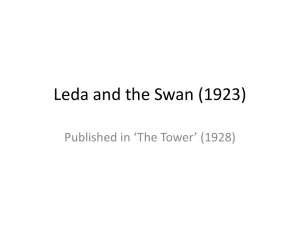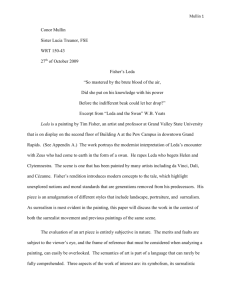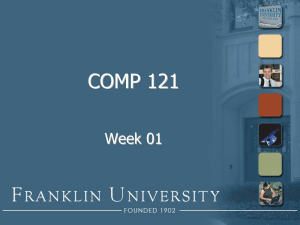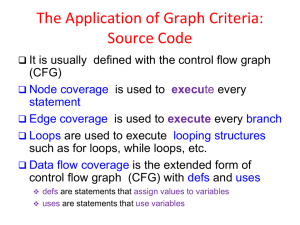LEDA intorduction slide
advertisement
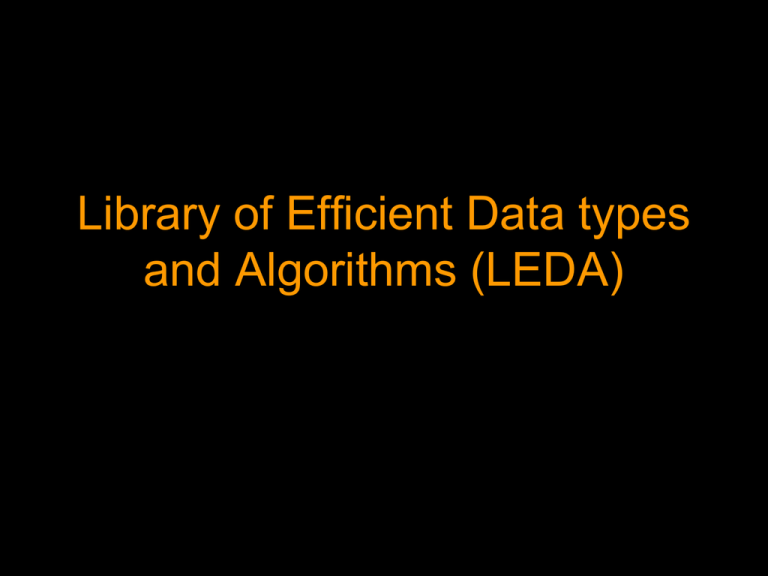
Library of Efficient Data types
and Algorithms (LEDA)
Outline
• Introduction to LEDA
- Basic data type
- Graphs
- GraphWin
• Resources of LEDA
LEDA Overview
• C++ class library for efficient data types and
algorithms
- Graph and network problems, geometric
computations, combinatorial optimization
Numbers
Windows
GraphWin
Basic Data Types
Geometry Kernels
Graphs
Advance Data Types
Geometry Algorithms
Embedded Graphs
Graph Algorithms
Ref: "LEDA A Platform for Combinatorial and Geometric Computing" CH.0 P.14 Fig.A
Basic Data Type
#include <LEDA/core/tuple.h>
<LEDA/core/string.h>
• String
• Tuple
#include <LEDA/core/string.h>
int main()
{
using
namespace leda;
leda::string a="thomas";
int main() leda::string b="christian";
{
leda::string c="thomas";
three_tuple<int,string,double>
if (a==c) std::cout << "a==c\n";
triple(17,"triple",3.1413);
//strings can be compared with ==
std::cout <<
std::cout
triple <<
<<std::endl;
b(0,4) << std::endl;
return 0; //outputs the first five letters of b
}
}
return 0;
Container
• Array
• Dictionary Array
leda::array<int> A(1,100);
d_array<string,string>
D;
int i;
//objects
of type string, keys of type string
for (i=A.low(); i<=A.high(); i++)
D["hello"]="hallo";
A[i]=i;
D["world"]="Welt"; D["book"]="Buch";
std::cout
string
s; << A[73] << " " << A[99] << std::endl;
forall_defined(s,D) std::cout << s <<
" " << D[s] << std::endl;
GraphWin
• The GraphWin combines Graphs and Windows
• Applications
- An Interactive GUI
- Construct and display graphs
- Visualize graphs and the results of graph
algorithms
Create a GraphWin
GRAPH<int, int> G;
GraphWin gw;
//initial the graph
random_simple_undirected_graph(G, 4, 3);
Make_Connected(G);
//set graphwin
gw.set_graph(G);
gw.set_edge_direction(undirected_edge);
//show graphwin
gw.display(window::center,window::center);
gw.edit();
Graph
• Elements in a Graph
- Node set
- Edge set
Node
Edge
Graph Representation
1
1
3
3
2
2
Graph Data Structure
• Node
- Node name
- Neighbor
- Serial number
- Weight
• Edge
- Edge name
- Serial number
- Weight
- Source
- Sink
class NODE{
string name;
vector<NODE> neighbor;
int sn;
int weight;
};
class EDGE {
string name;
int sn;
int weight;
NODE source;
NODE sink;
};
Basic Graph Operation
•
•
•
•
Insert a node
Delete a node
Insert an edge
Delete an edge
Graphs
GRAPH<string, string> G;
node n_temp1, n_temp2, n_temp3, n_temp4, n_temp5;
n_temp1 = G.new_node(“A”);
n_temp2 = G.new_node(“B”);
n_temp3 = G.new_node(“C”);
n_temp4 = G.new_node(“D”);
n_temp5 = G.new_node(“E”);
D
A
C
G.new_edge(n_temp1, n_temp2);
G.new_edge(n_temp2, n_temp3);
G.new_edge(n_temp3, n_temp4);
G.new_edge(n_temp3, n_temp5);
B
E
Graph Traversal Example
• Depth-First Search
Bread-First Search
5046132
5012436
5
5
0
0
2
4
1
6
2
4
1
6
3
3
Example Code
Graph construction
DFS
BFS
Graph Traversal Visualization
BFS
DFS
Min Cut Example
The minimum cut has value: 3
cut:[3][1]
1
0
1
3
2
2
3
2
Example Code
Graph construction
Min cut algorithm
Outline
• Introduction to LEDA
- Basic data type
- Graphs
- GraphWin
• Resources of LEDA
Resource of LEDA
• LEDA Office Page
- http://www.algorithmic-solutions.com/leda/
• LEDA User Manual
- http://www.algorithmic-solutions.info/leda_manual/manual.html
• LEDA Guide
- http://www.algorithmic-solutions.info/leda_guide/Index.html
• The LEDA Platform of Combinatorial and
Geometric Computing
- http://www.mpi-inf.mpg.de/~mehlhorn/LEDAbook.html
Compilation on Workstation
• In NTHU-CAD
- g++ -c –g -I/users/student/yourid/LEDA_lib/LEDA/incl -c -o test.o
test.cpp
-
g++ -o test test.o -L/users/student//yourid/LEDA_lib/LEDA -lG -lL -lm;
• g++ parameters
- -I: location of the LEDA header files
- -L: location the LEDA library files
Appendix
Final Project
(FPGA Technology Mapping)
Logic description
Decomposition process
Technology mapping
A mapped logic description
( a general graph)
Minimize the number
of required Boolean
operations from
primary input to
primary output
Use K-input LUTs to
cover networks for
timing optimal
Two-input Decomposition
• Decompose multi-input operation to two-input
operation
• Minimize the number of operation from inputs to
outputs
Decomposed Network (1)
• The level of the decomposed network is 4
Decomposed Network (2)
• The level of the decomposed network is 5
Technology Mapping in FPGA
• Logic function is composed of LUT
• Minimize the level and number of LUT
PIs
a
Fv
c
b
d
e
v
3-feasible
cone Cv
Delay of 2
Inputs & Outputs
Overall Flow
Your algorithm
Two-input
Decomposition
FPGA technology
mapping
Notice
• Both the number of LUT and the height of the circuit
are scored
- the level of LUT is the main consideration
- the number of LUT minimization is optional
• The Boolean functionality of your mapped circuit
must be equivalent to that of original circuit.
- SIS command (eq. verify)
• You can download the static library file of LEDA
from course web site and use the graph algorithm
provided by LEDA API in your code.
- http://www.algorithmic-solutions.com/leda/index.htm
Most Important …
• Please follow the format of run-time example.
- map –k 4 map01.blif output.blif
TA will test your
program with
different K-input
size
Due Day
1/14 (Tue) 2014
Come to TA office (R227 EECS building) and
demo your program & report



